
The House of Este is a European dynasty of North Italian origin whose members ruled parts of Italy and Germany for many centuries.

Modena is a city and comune (municipality) on the south side of the Po Valley, in the Province of Modena, in the Emilia-Romagna region of northern Italy.

The Duchy of Modena and Reggio was an Italian state created in 1452 located in Northwestern Italy, in the present day region of Emilia-Romagna. It was ruled since its establishment by the noble House of Este, and since 1814 by the Austria-Este branch of the family. The Este dynasty was a great sponsor of the arts, making the Duchy a cultural reference during the Renaissance and Baroque periods.

Ercole III d'Este was Duke of Modena and Reggio from 1780 to 1796, and later of Breisgau. He was a member of the House of Este.

Rinaldo d'Este was Duke of Modena and Reggio from 1694 until his death, as well as a member of the House of Este. He was succeeded by his son.

Francesco III d'Este was Duke of Modena and Reggio from 1737 until his death.
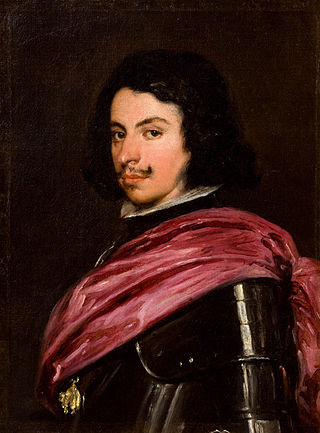
Francesco I d'Este was Duke of Modena and Reggio from 1629 until his death. The eldest son of Alfonso III d'Este, he became reigning duke after his father's abdication.

Charlotte Aglaé d'Orléans was Duchess of Modena and Reggio by marriage to Francesco III d'Este. She was the third daughter of Philippe II, Duke of Orléans and his wife, Françoise-Marie de Bourbon. She was born a princesse du sang, and had ten children, including Ercole III d'Este, Duke of Modena.
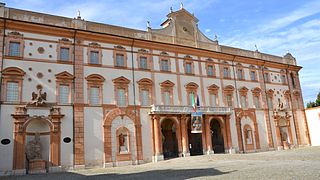
The Ducal Palace in Sassuolo is a Baroque villa located in the town of Sassuolo, thirty minutes outside Modena, northern Italy.
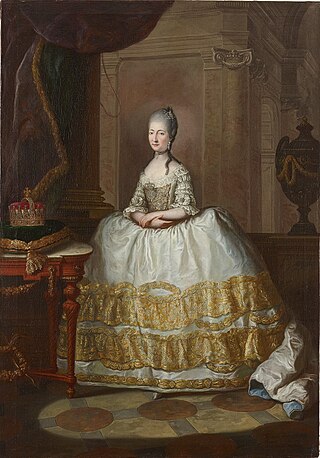
Maria Beatrice d'Este was the last descendant of the House of Este, of the House of Cybo-Malaspina and, through her maternal grandmother Ricciarda, also of the House of Gonzaga of Novellara and Bagnolo. Ducal princess of Modena and Reggio, she became the sovereign duchess of Massa and Carrara from 1790 until 1796 and from 1815 until her death in 1829. Through her marriage, she was co-founder of the new House of Austria-Este.

Charlotte Felicitas of Brunswick-Lüneburg was a German noblewoman. She was born into the House of Hanover and later married into the House of Este, which were both part of the House of Welf. She was thus the Duchess of Modena by marriage. She died in childbirth. Some sources refer to her simply as Charlotte.

Princess Enrichetta d'Este was a Duchess of Parma by marriage to her cousin Antonio Farnese, Duke of Parma. She was the Regent of Parma in 1731 during her alleged pregnancy in the interregnum after her husband's death.
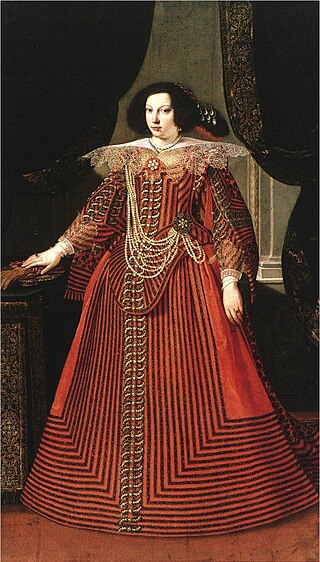
Maria Caterina Farnese was a member of the Ducal House of Farnese. She was Duchess of Modena as the first wife of Francesco I d'Este, Duke of Modena. In some sources she is known simply as Maria Farnese.

The Palazzo Estense is a Baroque palace built for Francesco III d'Este and the House of Este in Varese, Italy.

The Galleria Estense is an art gallery in the heart of Modena, centred around the collection of the d’Este family: rulers of Modena, Reggio and Ferrara from 1289 to 1796. Located on the top floor of the Palazzo dei Musei, on the St. Augustine square, the museum showcases a vast array of works ranging from fresco and oil painting to marble, polychrome and terracotta sculpture; musical instruments; numismatics; curios and decorative antiques.
The Gallerie Estensi is a network of three museums and a library, bringing together the collective fruits of artistic production from Ferrara, Modena and Sassuolo in the Emilia-Romagna region of Northern Italy. The galleries aim to preserve the historic heritage left by the influential House of Este, with a focus on relating their noble past to the local communities at each site.

Amalia Giuseppina d'Este was an Italian noblewoman and princess of Modena and Reggio by birth.
Borso d'Este was an Italian general, a member of the ducal House of Este. He was the son of Cesare d'Este, Duke of Modena and Virginia de' Medici.
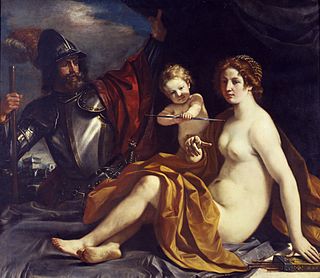
Venus, Cupid and Mars is a 1633 oil-on-canvas painting by the Italian Baroque painter Guercino, commissioned by Francesco I d'Este for his Ducal Palace of Sassuolo around 1632–1633, when the artist was in that city to paint portraits of the d'Este family. It is now in the Galleria Estense in Modena.

The ‘‘‘Ducal Palace of Rivalta’’’ was a baroque palace in Rivalta, just south of Reggio Emilia, Itay. The palace and its park were inspired by the Palace of Versailles. Until 1796, it served as a residence of the dukes of Modena from the House of Este, after which it fell in disrepair. Today, only the southern wing remains.

























